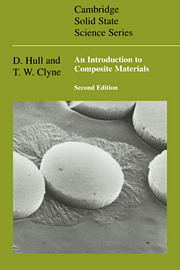Book contents
- Frontmatter
- Contents
- From the preface to First Edition
- Preface to Second Edition
- 1 General introduction
- 2 Fibres and matrices
- 3 Fibre architecture
- 4 Elastic deformation of long-fibre composites
- 5 Elastic deformation of laminates
- 6 Stresses and strains in short-fibre composites
- 7 The interface region
- 8 Strength of composites
- 9 Toughness of composites
- 10 Thermal behaviour of composites
- 11 Fabrication
- 12 Applications
- Appendix: Nomenclature
- Author index
- Subject index
11 - Fabrication
Published online by Cambridge University Press: 05 June 2012
- Frontmatter
- Contents
- From the preface to First Edition
- Preface to Second Edition
- 1 General introduction
- 2 Fibres and matrices
- 3 Fibre architecture
- 4 Elastic deformation of long-fibre composites
- 5 Elastic deformation of laminates
- 6 Stresses and strains in short-fibre composites
- 7 The interface region
- 8 Strength of composites
- 9 Toughness of composites
- 10 Thermal behaviour of composites
- 11 Fabrication
- 12 Applications
- Appendix: Nomenclature
- Author index
- Subject index
Summary
An important aspect of composite materials concerns the technology by which they are produced. Depending on the nature of matrix and fibre, and the required architecture of the fibre distribution, production at reasonable cost and with suitable micro structural quality can be a challenging problem. In most cases, manufacture of the final component and production of the composite material are carried out at the same time. This gives scope for optimal fibre placement, but also demands that the mechanical requirements of the application be well understood and that the processing route be tailored accordingly. Fabrication procedures for most polymer composites are commercially and technically mature, while most of those being applied to metal and ceramic composites are still under development. In many such cases, commercial exploitation will be dependent on improved fabrication efficiency.
Polymer composites
There are many commercial processes for the manufacture of PMC components. These may be sub-divided in a variety of ways, but broadly speaking there are three main approaches to the manufacture of fibre-reinforced thermosetting resins and two distinct production methods for thermoplastic composites. These are briefly covered below under separate headings. A simple overview of the starting materials and approaches adopted to their incorporation into components is given in Fig. 11.1. In most cases, the main microstructural objectives are to ensure that the fibres are well wetted, uniformly distributed and correctly aligned. Practical considerations relating to capital cost, speed of production and component size and shape capability are often of paramount importance.
- Type
- Chapter
- Information
- An Introduction to Composite Materials , pp. 271 - 294Publisher: Cambridge University PressPrint publication year: 1996
- 1
- Cited by



